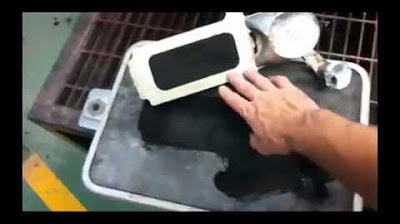Materiais e Processos de Fabricação para Engenharia de Produção - Fundição - Solidificação, defeitos
Summary
TLDRThis lesson dives into the metal casting process, focusing on the solidification phenomenon and the defects that occur as molten metal cools and solidifies. The solidification process differs for pure metals and alloys, with alloys forming dendritic structures and pure metals forming random crystal structures. The video also explores common casting defects like filling failures, cold shuts, micro-porosity, and hot cracks. Additionally, various casting methods are covered, including sand casting, permanent mold casting, shell molding, and investment casting (lost-wax). Understanding these processes and defects is crucial for producing high-quality metal castings.
Takeaways
- 😀 The solidification process in metal casting occurs as molten metal cools and transforms into a crystalline structure, starting at the cooler parts of the mold.
- 😀 Pure metals solidify with randomly oriented grains, while alloys typically form a dendritic structure, especially in the center of the mold.
- 😀 Solidification moves from the mold's surface (cooler) to the center (hotter) following the heat flow direction, forming fine, columnar grains at the mold walls.
- 😀 Three types of volumetric contraction occur during casting: during the liquid phase, during solidification, and when the solid metal continues to cool.
- 😀 Common casting defects include filling failures (incomplete mold filling), cold shuts (improperly joined metal flows), and cold drops (metal droplets from splashing).
- 😀 Porosity in castings, including contraction cavities, microporosity, and hot tears, can negatively affect the final product's integrity and strength.
- 😀 **Contraction Cavities** form when the solidifying metal shrinks but isn't replenished with enough molten metal.
- 😀 **Microporosity** occurs when small gas bubbles are trapped within the metal during solidification, leading to tiny cavities throughout the piece.
- 😀 **Hot Tears** occur when uneven cooling rates during solidification cause cracks to form in the metal, especially in high-temperature areas.
- 😀 Sand molds have specific defects like gas bubbles, erosion, penetration, and deformation due to the liquid metal's movement, all of which can degrade casting quality.
- 😀 Permanent molds, which can be reused, are suitable for metals with lower melting points (e.g., aluminum, zinc, magnesium) and offer better surface finish and dimensional precision.
- 😀 Advanced casting techniques include **Shell Molding**, where sand and resin are used to create a rigid shell, and **Lost Wax Casting**, which is ideal for complex shapes like jewelry.
Q & A
What happens to the structure of metal when it solidifies?
-When metal solidifies, it forms a crystalline structure made up of defined geometric positions of atoms. This structure is initially random in pure metals and becomes more ordered as solidification progresses.
What is nucleation in the context of metal solidification?
-Nucleation is the process where atoms in the liquid metal collide and form small nuclei, which grow as the metal solidifies, eventually forming grains in the final solid piece.
How does the solidification process differ for pure metals and alloys?
-In pure metals, the solidification begins with random orientation of crystals and then transitions to a columnar structure. In alloys, solidification forms dendritic structures (branch-like formations) and the temperature changes during the phase transition.
What are dendrites, and how do they form in alloys?
-Dendrites are tree-like structures that form in alloys during solidification. As the metal solidifies, the dendrites grow perpendicular to the mold walls and eventually form a network in the center of the solidified mass.
What is the difference between solidification in pure metals and alloys in terms of temperature?
-In pure metals, the temperature remains constant during the phase change from liquid to solid. In alloys, the temperature decreases gradually during the solidification process, which is influenced by the chemical composition of the alloy.
What are the three types of volumetric shrinkage in the casting process?
-The three types of volumetric shrinkage in casting are: 1) shrinkage during the cooling of the liquid before solidification, 2) shrinkage during the phase change from liquid to solid, and 3) further shrinkage as the solidified metal cools down after the phase change.
What are the main defects that can occur in a cast metal piece?
-The main defects include filling failures (where parts of the mold are not filled), laminations (when metal portions solidify at different times), cold shuts (small solid metal droplets formed during pouring), contraction cavities (due to shrinkage), microporosity (small voids from gas release), and hot tears (cracks formed due to uneven cooling).
How can defects like microporosity and hot tears be avoided in casting?
-Microporosity can be reduced by controlling the release of gases during solidification, while hot tears can be avoided by ensuring uniform cooling and well-controlled pouring processes to prevent uneven contraction in the cast.
What are the advantages and disadvantages of using permanent molds in casting?
-Permanent molds, made of metal, offer advantages like better surface finish, higher dimensional accuracy, and faster production rates for simpler shapes. However, they are limited to metals with lower melting points and are typically not suitable for complex parts.
What is the process of shell molding in casting, and how does it differ from traditional sand molding?
-Shell molding involves using a mixture of sand and resin to form a rigid shell around the model. Unlike traditional sand molds, the resin helps bind the sand particles together, allowing for a stronger, more precise mold. This process also allows for easier recycling of the sand mixture.
Outlines

This section is available to paid users only. Please upgrade to access this part.
Upgrade NowMindmap

This section is available to paid users only. Please upgrade to access this part.
Upgrade NowKeywords

This section is available to paid users only. Please upgrade to access this part.
Upgrade NowHighlights

This section is available to paid users only. Please upgrade to access this part.
Upgrade NowTranscripts

This section is available to paid users only. Please upgrade to access this part.
Upgrade Now5.0 / 5 (0 votes)





